

Wheel pants: Aero aid, fashion statement, or dangerous duds?
 |
In the early 1970s, I was a newly minted teenager in junior high, trying to impress the girls by styling in bell-bottom pants. Meanwhile, miles away geographically but never far from my brain, Top Fuel was going through its own fashion-statement experiment with the addition of front-wheel enclosures – alternately known as fairings or, more colorfully, wheel pants – to numerous cars. Although anyone who saw them won’t soon forget them and might tend to think that they were a widespread phenomenon, their actual number was limited to just about 25 cars in about a three- or four-year span before they were outlawed by NHRA.
They certainly looked sexy, and despite some proclamations that they were nothing more than “eyeball aero” or a fashion statement, one could easily understand the logic behind adding a knifepoint covering to the tires to complement any other swoopy nosework on a dragster. The fact that the rapidly rotating tires create a significant air disturbance – the top of the tires reportedly are traveling at more than twice the speed of the car – was vividly borne out more than a decade later when at the 1985 U.S. Nationals “Big Daddy” Don Garlits observed Top Fuel cars disturbing the rice-hull-ash residue from an oildown cleanup 20 to 30 feet in front of the car, which led to his covering his front tires the next year with a full nosepiece on Swamp Rat XXX, leading to his breaking of the 270-mph barrier just two years after 260 had been topped (whereas it had taken nine years to go from 250 to 260).
 |
Although widely associated with the rear-engine-dragster design, wheel pants were actually on land-speed king Craig Breedlove’s enclosed-cockpit Spirit of America slingshot in 1964 shown at right.
I can’t pin down who first ran them on a rear-engine car, but certainly there was no bigger advocate than “TV Tommy" Ivo, who made hundreds of runs with them on a number of his cars yet, ironically, suffered perhaps the most famous top-end tumble of a car running wheel pants when he flipped his beautiful car during qualifying at the 1974 Winternationals. To this day, he says that the wheel pants had nothing to do with the accident, but after crashes involving the pants-wearing Top Fuelers of Dick LaHaie and Don Roberts and the fatal accident involving Russell Mendez’s similarly equipped Free Spirit rocket dragster at the 1975 Gatornationals, NHRA outlawed the devices at the end of the 1976 season.
The knock against the wheel pants seemed an obvious one, that they would act as rudders in a crosswind and point the car in the direction of the wind, but – and I’m no aerodynamicist – that would only seem to be true if there were more area in front of the axle than behind it, which did not seem to be the case in photos I have studied. With more side area behind the center point, theoretically they would steer into the wind and be self-centering (as described in the Drag Racing USA story on the wheel-pants-equipped Barry Setzer monocoque dragster).

Steve Reyes photo
|
I have heard several tales of drivers turning their front tires in mid-wheelstand to direct their cars, so I can see that side of the coin as well, that once a car was off a straight line, the wheel pants might exacerbate the situation, with air pressure on the side of the pants making it hard for a driver to fight the tires straight.
It only took the experimentive-by-nature Garlits one pass, during qualifying at the 1973 Winternationals, with wheel pants to decide that he didn’t need any more experimentation.
“I had Nye Frank make me up a nice set, and I put them on for my first run in Pomona,” Garlits said. “I knew everything about that car, everything it would do, but on that first pass, I went to make a little correction at the finish line, and the car just darted over toward the guardrail because those things were like rudders. I took them off right away. I still have them – they’re sitting right next to the car in the museum – but I never ran them again.”
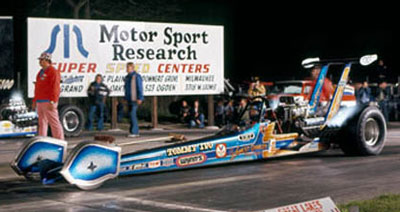
Tommy Ivo ran wheel pants on his Top Fuelers for three seasons, including 1973 (above) and 1975 (below; Reyes photos), for hundreds of runs and only crashed once, at the 1974 Winternationals (bottom; Paul Sadler photo).
|
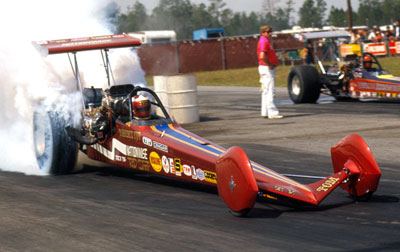 |
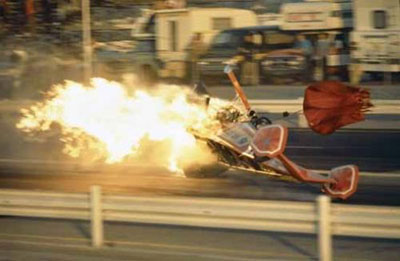 |
Ivo’s crash, a year later in Pomona, got much play thanks to a brilliant color-photo sequence by Paul Sadler. Ivo had run the wheel pants without issue in 1973, but the sight of the car up on two wheels with those fairings seemingly pointing the way to the guardrail looked like Exhibit A in their guilt, but that was far from the case, according to Ivo.
“I ran [wheel pants] on three different rear-engine dragsters for three seasons,” said Ivo. “I ran about 250 to 300 runs a season, depending on how many rainouts we had. I ran my first Woody [Gilmore-built] car with no wheel pants for a full season. I then took that same car and painted it blue and just put the wheel pants on, with a flared-out nosepiece, and ran it another 250-plus runs. I ran both of them in all kinds of conditions. Short, narrow, rough, crosswinds, rain, and just about anything else you can think of and never could tell one iota of difference between them.
“The wheel pants absolutely had nothing to do with [the Pomona crash],” said Ivo adamantly. “I have step-by-step pictures of the pants in perfect line during the entire crash. We had mounted the wing lower on the car to give it a more paper-dart look. My chassis builder [Larry Sikora] had come up with the idea, and it seemed like a good one to me. When the engine blew up, I started to slightly slip to the side from running over the oil [and the fact that the huge fire behind the car sucked up the air, holding the rear wing down].
“As I lifted my foot off the gas pedal, it was as though it had a string tied to the right rear wheel, and the reverse torque of the motor barrel-rolled it over to the left. We kept the cockpit and front- and rear-ended it, just exactly as it was before the crash. We ran it for about another four or five races before I put the pants back on again. Nope -- no difference whatsoever. Another season with no difference with them on or off of the car. The next year, we ran them on the Rod Shop dragster for yet another 250-plus-run season: nothing.”
Others weren’t so lucky.
LaHaie’s Top Fueler and Mendez’s rocket car, both equipped with the wheel fairings, crashed at the 1975 Gatornationals, and LaHaie crashed another wheel-pants car later that year in Indy, but LaHaie, like Ivo, is firm in his belief that the wheel pants had nothing to do with either.
LaHaie’s Gainesville crash came on the first pass in a new car – he had run the NHRA and AHRA Winternationals with a heavy car (also with wheel pants) but had a new one built for the Gatornationals – when the throttle stuck. Thinking quickly, LaHaie depressed the clutch, blowing the engine on purpose, then grabbed for the chute. An already tricky situation got even worse when the face shield blew off of his helmet. The car veered out of control and crashed heavily, tearing off his left hand (fortunately for him, a group of medically trained Vietnam veterans were in Gainesville teaching limb replacement and surgically reattached it) and breaking his right arm.
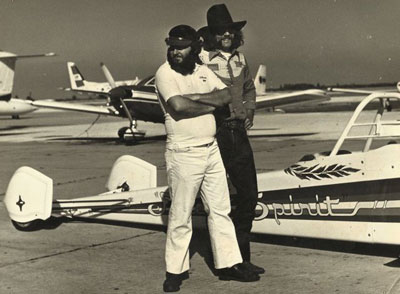
Car builder Glen Blakely, left, driver Russell Mendez, and the wheel-pants-equipped Free Spirit rocket dragster.
|
Mendez was not near as fortunate; his dragster made a hard right turn in the lights and plowed into the guardrail, killing him instantly (ironically, 37 years ago to this day, March 16, 1975). I’ve read reports, and there’s quite a debate among “experts” about what caused the usually stable car to veer out of control. Some blame the newly added wheel pants, others blame the effects of reconfiguring its fuel-bottle layout during the winter in a way that changed its center of gravity. Garlits has no doubts: “There’s no way a car could make a 90-degree turn like it made with those wheel pants,” he told me in Gainesville last weekend.
A month later, on a windy April 20, East Coast veteran Roberts got his first and last pass in the wheel-pants-equipped Jade Grenade Top Fueler at New England Dragway, where he lost control and crashed, fracturing his leg so severely that doctors were forced to amputate it below the knee. (After which Roberts was famously quoted, “It wasn’t a bad run, but after the third flip, I lost control.”)
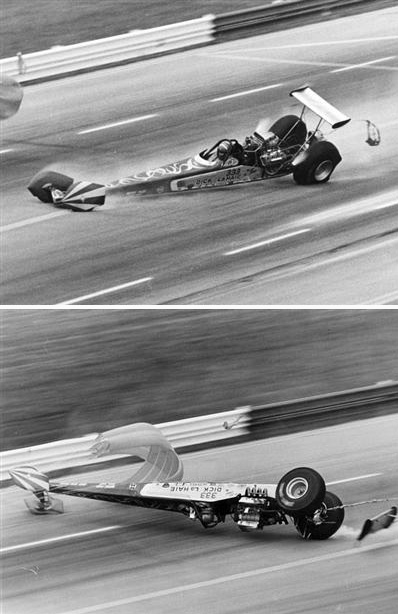 LaHaie had a new car built – still equipped with wheel pants – and debuted it a week before the U.S. Nationals at U.S. 30 Dragstrip and won the event, but on his third qualifying run in Indy, the left rear tire started to go away on a 6.16, 236-mph pass.
LaHaie had a new car built – still equipped with wheel pants – and debuted it a week before the U.S. Nationals at U.S. 30 Dragstrip and won the event, but on his third qualifying run in Indy, the left rear tire started to go away on a 6.16, 236-mph pass.
“I remember the feeling like it was yesterday,” LaHaie told me, well, yesterday. "I felt it shudder as it was coming up to the lights, like it was wadding up on itself. It blew the inner liner, and the tire got all crazy, and over it went. There wasn’t anything I could do about it."
LaHaie lost three toes (two of which were successfully reattached) and broke his right arm again in the accident but came back to race again the next season. He even credited the wheel pants with making the car more steerable when it carried the front end due to a problem with the front spoiler and said that he asked NHRA for permission to test them on Scott Kalitta’s championship-winning dragsters in the mid-1990s. “NHRA didn’t want any part of that,” he said.
I asked longtime friend Carl Olson why he and Mike Kuhl, both of whom were recently inducted into the International Drag Racing Hall of Fame, never experimented with wheel pants on their Kuhl & Olson Top Fuel entries.
“We didn't put front wheel pants on the K&O car for any number of reasons,” he explained. “Checking and servicing the front tires and wheels was a major issue. We liked to check the tire pressures on a regular basis, and getting to the valve stem was a big hassle with the pants installed. The complexity of installing and maintaining the pants was another issue. Weight was also a consideration, as we didn't run any ballast on the front end when we first went to the mid-engine car and always wanted to keep things as light as possible. We really didn't think the streamlining of the front wheels was much of an advantage, and we believed that the pants increased the frontal area enough to offset any advantage the streamlining may have provided. Finally, we were essentially budget racers and felt that the expense of the pants was difficult to justify with so many other areas in which to invest that had greater potential for improved results.
“As time went on, I observed that the pants were creating handling problems. Those were my personal observations. While I never had direct conversations with any of the drivers using the pants, I did hear some of their concerns through the grapevine. The incident that convinced me that the pants were downright dangerous was LaHaie's terrible crash at the U.S. Nationals. I observed that crash from a vantage point near the finish line and was convinced that Dick had struggled to keep the car pointed in the direction he wanted it to go. At that point in time, I did approach my contacts at the NHRA to voice my concerns and learned that they were already on the same page. Shortly thereafter, the pants were outlawed, much to my relief.”
(Interestingly, Olson helped LaHaie when the Division 3 driver's commission sought to revoke LaHaie’s license after two crashes in one season. “They felt his Indy crash was the result of his poor driving and judgment and that his injuries were so severe that he'd never be able to safely control a dragster,” remembered Olson. “I interceded on his behalf, provided my observations of his crash and subsequent study of the photos and felt that he would never get into a race car if he wasn't convinced that he was physically capable of driving it. They allowed him to keep his license, and he went on to be a champion and one of drag racing's greatest drivers. I've always been glad that I was able to help him continue on in the sport he loved so much.”)
I’d already heard so many times that 1975’s incidents provided the ammunition for NHRA to outlaw the wheel pants beginning with 1976 that it had become a de facto truth in my head (and in many of yours), so I figured that a quick tour through the final few 1975 issues of National DRAGSTER would yield the official announcement, but that wasn’t so.
A “We’ve Come A Long Way!” 25-year NHRA anniversary ad that appeared in the third issue of 1976 showcased the Pat Dakin-driven G.L. Rupp dragster wearing wheel pants, and Dakin’s car and that of Steve Stephens both competed at that year’s inaugural Cajun Nationals (April 23-25) with the wheel pants in place. Once I got halfway through the year, I decided to jump straight to the end and, sure enough, in the Nov. 19, 1976, issue was the proclamation “wheel fairings will not be allowed in 1977.” More revisionist history, eh? There was no explanation for the rule change and, to my knowledge, no other wheel-pants-equipped-dragster crashes in 1976, so it may have been that NHRA gave the teams a one-year grace period through 1976.
Concluded Olson, “I really think that some racers purchased and installed them because they just looked cool, while others (like Warren & Coburn) were convinced that they provided a performance advantage. All in all, it was an interesting chapter in dragster evolution and proved the point that not every idea that came down the road in those days was a good one. In my opinion, that was what was so great about that era of drag racing in that there was always serious experimenting going on, and you never knew what was going to work and what wasn't until you tried it.”
| Top Fuel cars with wheel pants: A list compiled by Mark Gredzinski | |||
| Lisa & Rossi | Warren & Coburn | Mike Snively/Jim Annin | Jade Grenade |
| Tommy Ivo | John Austin/Hot Tuna | California Charger | Barry Setzer |
| Don Garlits | Pat Dakin/G.L. Rupp | Terry Capp/Wheeler Dealer | Bob Williams |
| Dick LaHaie | Danny Ongais/Vels Parnelli Jones | Craig Breedlove (slingshot) | Johnny Abbott |
| Poncho Rendon | Stephens & Venables/Quicksilver | Bob Holley/American Express | Gary Dye |
| Vern/Bruce Hagestad | Tony Froome/Sundowner (England) | Bob Beaulieu/Eastern Raider | Mark Howick |



















































